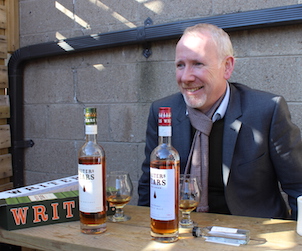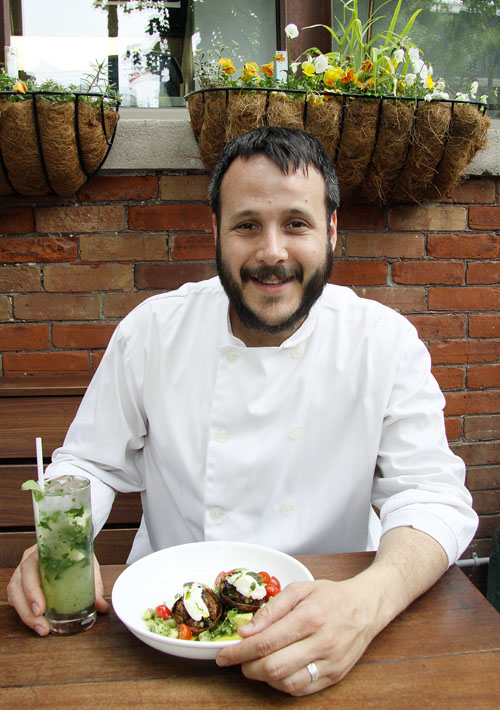Malcolm Jolley meets the man behind Writers’ Tears Single Pot Still Irish Whiskey.

Bernard Walsh is an Irish farmer’s son. One of nine children, he says his eldest brother was a very good farmer, so it was up to him to find something else to do. Initially this took him to the study of computer science and a career in software, where he says he “made a few pounds at the time”, and wanted to come home to Ireland “marry my girlfriend, have children, and do something different.”
Bernard Walsh did just that. He and his wife, Rosemary (also a farmer’s daughter), both loved wine and to travel in wine country, and they determined that in Ireland “our wines are whiskey and our vineyards are barley fields”. At first they began a successful business making a pre-made Irish Coffee product (just add boiling water and whipped cream), which they still sell. But eventually Walsh realized the dream of making Irish Whiskey in the old, 19th century style in a single copper pot still, using malted and green barley.
The Walsh Whiskey Distillery is near their home in Wicklow, south of Dublin. Bernard Walsh calls it the “heart of barley growing country”, and the distillery buys all of its barley from a pool of forty or so local farmers. Walsh’s best known, and widely available brand in Canada is called Writers’ Tears, and I tried (for the first time) two versions of it in his company recently, that are currently available at the LCBO:
- Writers Tears Copper Pot Irish Whiskey (LCBO# 271106, $46.95 700ml); and
- Writers Tears Red Head Single Malt Irsh Whiskey (LCBO# 494765, $64.95 700ml).
 Walsh is a charming man, so I was predisposed to like his whiskey, which I did very much. The Copper Pot has a warm spiciness and fruity quality without being sweet. It’s very (cliché alert) smooth – I don’t have another word for it. There’s basically no alcoholic burn. It also have long, long finish that pleasantly lingers. I was recording our conversation, for the interview below, while we tasted it and there is a long pause of several seconds while we wait for the taste to dissipate. It’s quite remarkable. I think The Copper Pot would make a lovely dessert, and I could happily settle into a glass of it after dinner, sipping it to see how long the finish might last. The Red Head is a ‘single malt’ whiskey, aged in mostly Oloroso Sherry casks for the full maturation, which may or may not account of nutty roundness to it, and a bit of dried fruit character on the nose. (It does in my imagination, anyway.) One of my notes for the Red Head is “calming” and it has a meditative quality to it. Like it’s cousin, The Copper Pot, it is also very smooth and long on the finish so all kinds of complexities can be revealed.
Walsh is a charming man, so I was predisposed to like his whiskey, which I did very much. The Copper Pot has a warm spiciness and fruity quality without being sweet. It’s very (cliché alert) smooth – I don’t have another word for it. There’s basically no alcoholic burn. It also have long, long finish that pleasantly lingers. I was recording our conversation, for the interview below, while we tasted it and there is a long pause of several seconds while we wait for the taste to dissipate. It’s quite remarkable. I think The Copper Pot would make a lovely dessert, and I could happily settle into a glass of it after dinner, sipping it to see how long the finish might last. The Red Head is a ‘single malt’ whiskey, aged in mostly Oloroso Sherry casks for the full maturation, which may or may not account of nutty roundness to it, and a bit of dried fruit character on the nose. (It does in my imagination, anyway.) One of my notes for the Red Head is “calming” and it has a meditative quality to it. Like it’s cousin, The Copper Pot, it is also very smooth and long on the finish so all kinds of complexities can be revealed.
This interview has been edited for length, clarity and style.
Good Food Revolution: Until I looked up your website recently, I had just assumed that Writers’ Tears had been around for ever. Somehow, as a brand, it permeated my consciousness. But, actually your company and the brand are pretty new, by whiskey standards, aren’t they?
Bernard Walsh: My wife and I started our company in 1999, so we like to think of ourselves as being there when the Irish whiskey renaissance began, when the industry re-started. There’s been about 20 years of regrowth. Before then, one firm controlled 95% of the sales of Irish whiskey. We were young upstarts, and we saw loads of opportunity for something left and right of the middle ground.
Good Food Revolution: Did you know ahead of time what you wanted to make, or did you have to rediscover what was possible first?
Bernard Walsh: The discovery part was finding out where Irish whiskey was in the 17 and 1800’s, and what made it great. I wanted to go back there and recreate some of those expressions, and that’s what we’ve done. Every one of our spirits, including all the ones we sell here in Canada, are all distillates of the copper pot, as opposed to the column. We don’t have grain blends, we have pot and grain blends: pot and malt whiskeys. We’ve pushed Irish whiskey out form that centre ground and we’re exploring. So, we did it but it was an experiment. We didn’t know if it would work, so it was very much one foot at a time.
 Good Food Revolution: Can you tell more about pot still whiskey?
Good Food Revolution: Can you tell more about pot still whiskey?
Bernard Walsh: It’s a style unique to Ireland. The Scots have grain and single malt whisky, we’ve got malt, grain and pot still. I believe that the single pot still style of whiskey in years to come will be the jewel in the crown of Irish whiskey. It will be like what the single malts have become for Scotland at the moment. That didn’t happen overnight. That took 40 years to develop to where it is today. We would like to take single pot still whiskey there, but it’s a long program and we’re still experimenting to do it.
Good Food Revolution: Like how?
Bernard Walsh: I’ll give you an example: in January we distilled Ireland’s first organic single pot still Irish whiskey. Nobody’s knocking on my door looking for it, but I think in 10 years time there will be a need and a demand for it. And, actually, it tastes amazing. Even straight from the still, you can tell it’s going to be fantastic. It’s 82% a.b.v. (not proof), and it’s got a lovely mouthfeel: creamy, no burn and we haven’t even aged it.
Good Food Revolution: And what about what you make now?
Bernard Walsh: We have two brands: The Irishman and Writers’ Tears. The Irishman majors more on the malt side, and Writers’ Tears majors more on the pot still side. Not exclusively, but that tends to be their angle. Writers’ Tears is real left of centre, The Irishman is more traditional. In the LCBO at the moment, we have three expressions of Writers’ Tears: The Copper Pot, The Red Head, and The Cask Strength, which is a limited Vintages offering. And we’re working on listings for the Irishman, focusing on single malts: 12 year old, 17 year old.
Good Food Revolution: You know that I am compelled to ask you where the name for Writers’ Tears came from.
Bernard Walsh: That’s alright, a lot of people ask me that. [Chuckles.] In Ireland we had the rise of whiskey and the rise of Irish writing at the same time: Oscar Wilde, George Bernard Shaw, James Joyce, Bram Stoker… the list is endless. Even to this day, if you come to Dublin you’ll see in all the old pubs they’ll have a plaque saying this is where Bram Stoker or James Joyce used to drink. They all had their favourite watering holes and they drank whiskey and wrote about it. Say they had writers’ block, they go to their local pub and take a whiskey and sit there and watch life go by. Nobody knew how much whiskey they had, but what they did know is when they cried their tears were of whiskey.
Good Food Revolution: I thought there would be a good story behind it.
Bernard Walsh: It’s a reflection of an era when both whiskey and writing were just intertwined. I’m really in awe of the people that are creative, whether it’s in writing or the arts, music, farmers. They’re out there creating using their hands and their heads. So it’s also the tears of creation, the struggles they have. And, on the flip side, the joys and the tears at the end.
Find out more about Walsh Whiskey Distillery at walshwhiskey.com.







